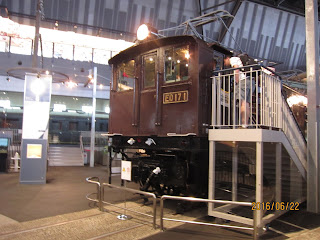This is the E255 leaving.
This is a rapid train service that came in on the track opposite.
From Tokyo Station we rode a Kagayaki Shinkansen to Omiya.
Which was where we caught the New Shuttle Line, which was running the newest stock that they had, the 2020 series. Last year when we visited we rode on the 1010 series, which was the oldest stock. They retired them on June 26 this year, so I made a tribute. It has the oldest type and the newest type in it.
This is number 21 at the Railway Museum stop.
Since it was mildly foggy out I was worried that the shinkansen viewing platform would close like it did last time, I got my railfanning done early. This is a video of all the shinkansen that we saw, plus some at Omiya Station.
Well, after some successful morning railfanning, we headed into their diorama area where they had their models.
This is a 200 series shinkansen that was used on the Joetsu and Tohoku Shinkansen.
This is an E233 used on the Shonan-Shinjuku, Takasaki, and Utsunomiya line trains.
This is a 100 series.
And a 651 series limited express set.
An E5.
E6.
Narita Express.
Coupled together...
Series 253 Nikko.
This is the main concourse of the museum, which is where they keep almost all of their large pieces of equipment. The first time we went to this place, there was a steam locomotive on the turntable, but in 2015 they completely rearranged the exhibits, and now there is a EF55 electric locomotive.
This is said EF55.
Along with the back.
Apparently these were placed at the heads of tunnels. They were gigantic; why would you put those there?!
This is a model of a snowplow used in Hokkaido and also Benkei, Hokkaido's first train.
This is the 0 series, which is pretty much the main attraction at this museum. The 0 series was the first shinkansen in Japan, from 1964. They were delivered in the Yokohama Port, and they were run on the Tokaido Shinkansen, between Tokyo and Osaka.
In the museum they have these little trains that kids can drive around the track. This is one of the decommissioned models, a series 209 formerly "used" on the Keihin-Tohoku Line.
This is a Japanese Hi-railer, or a truck that runs on the rails.These two are lunch trains. They are former 485 series EMUs, but now people eat their lunches inside.
Inside the little model, you can see the plated controllers.
And also the signs talking about the transceiver.
This is the head of a 200 series shinkansen inside.
And a model JRF train. (Japan Rail Freight)

Hey! An SP U-boat!
And a EF66 that I saw both this year and last.
This is an EMU freight train, meaning that it is using distributed power.
Which means that the trains are powered by something other than the locomotive.
This is a bonnet-type 485 series express train running on a Hibari service.
And a ED75 pulling a night train. Something to do with the ocean, that's all I know.
And another EF66! This is from the first batch. These trains pulled freight and all the night trains that Japan used to have running. Now they just have three.
This is a very old EMU.
And another.
This is the EF55 that was on the turntable.
And this was the steam locomotive on the turntable in 2013.
This is ED17 1, an electric locomotive.
This is a trolleybus-like train, because it has two poles in the back as opposed to one pole or a pantograph.
This is ED40 10, a rack locomotive that used to run on the Usui Pass between Yokokawa and Kanazawa.
This is another electric locomotive, EF58 89.
The Asakaze was another one of those sleeper trains.
These are the little trains I was talking about. This was the former Narita Express stock, series 253.
These are the three types of trains that will be seen on the New Shuttle, excluding the new 2020 series. From left to right, that's the 2000 series, which I have ridden, the 1200 series, which I have not ridden, and the 1010 series, which I rode last year.
Well, now that we are on the Hokkaido Shinkansen, this is the double-gauge Tsugaru-Kaikyo Line. Originally regular passenger trains and freight trains were together on this line, but now that the Hokkaido shinkansen is up and running, they had to add a third rail because of the gauge difference. Now almost no passenger trains run (except for the Hayabusa and the Hayate shinkansen) in the tunnel, but that track is still there because freight trains still run.
Inside the Seikan Tunnel...
This is the interior of Shin-Hakodate-Hokuto station.
And this is the Hakodate Liner that we took to Hakodate Main Station.
They had door controls!
This was our train at Hakodate Main Station.
And this is a special South Hokkaido Railway KiHa 40 tourist train.
Next post will be about Goryokaku Tower and Mt. Hakodate.





















































No comments:
Post a Comment